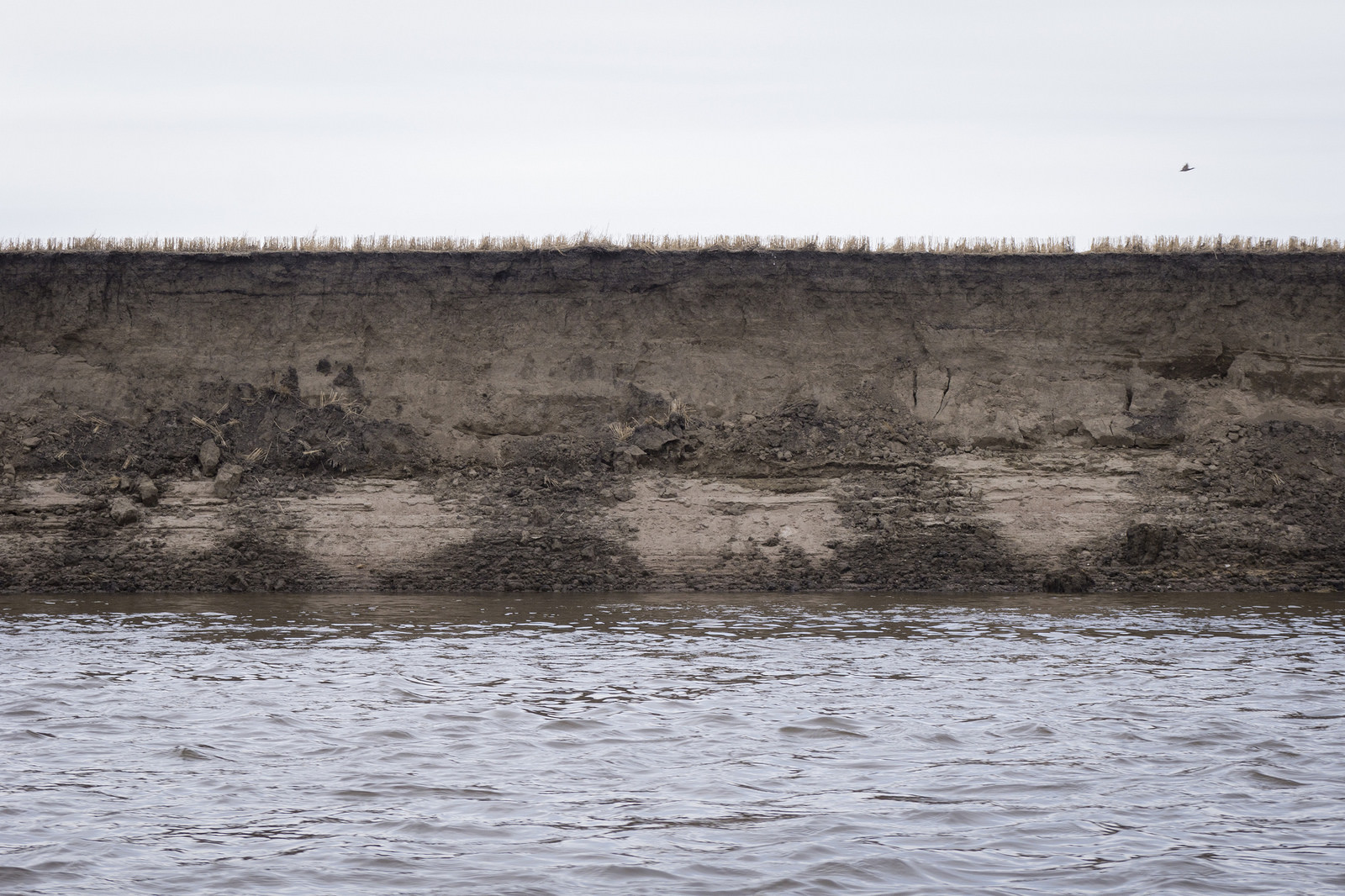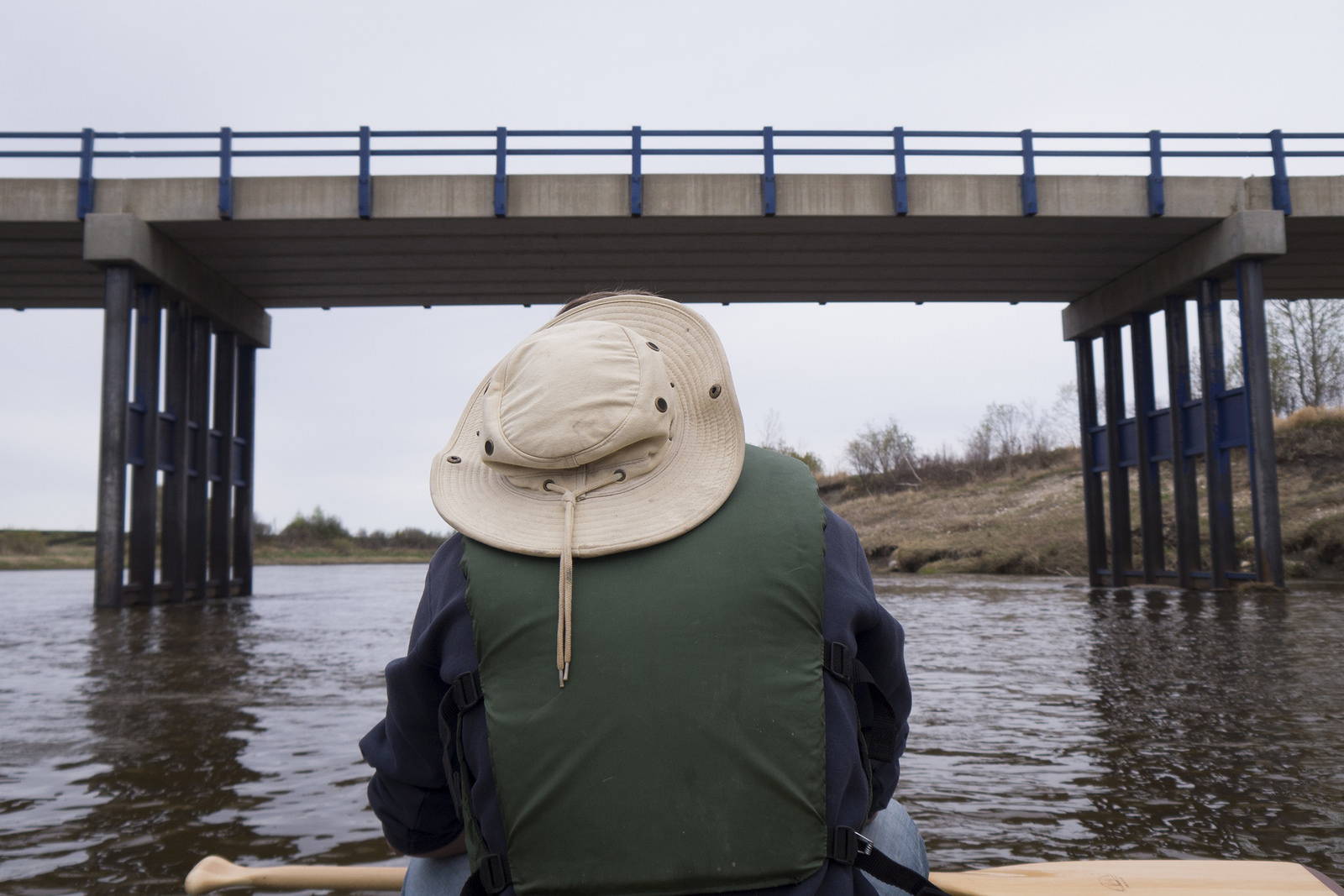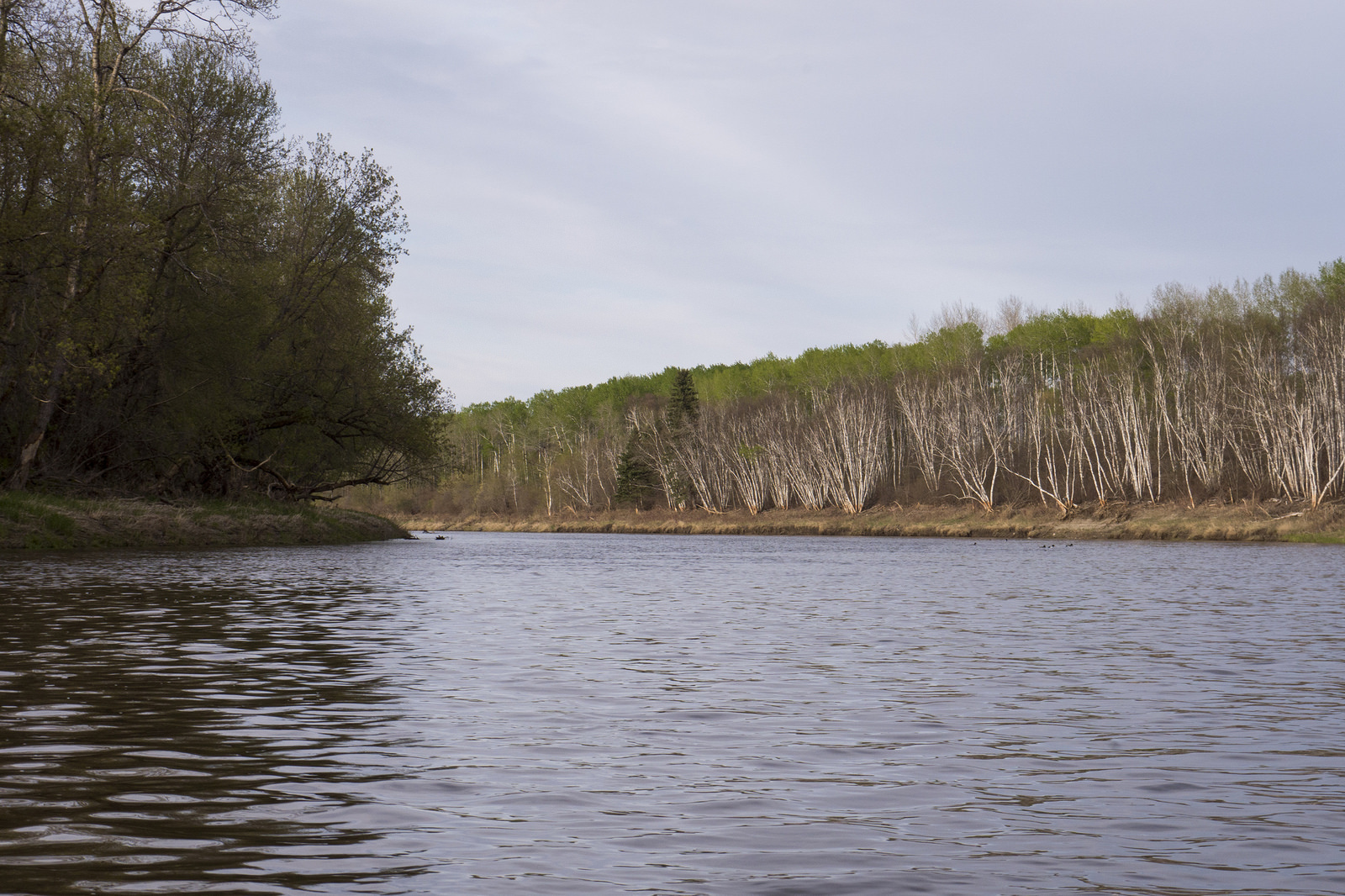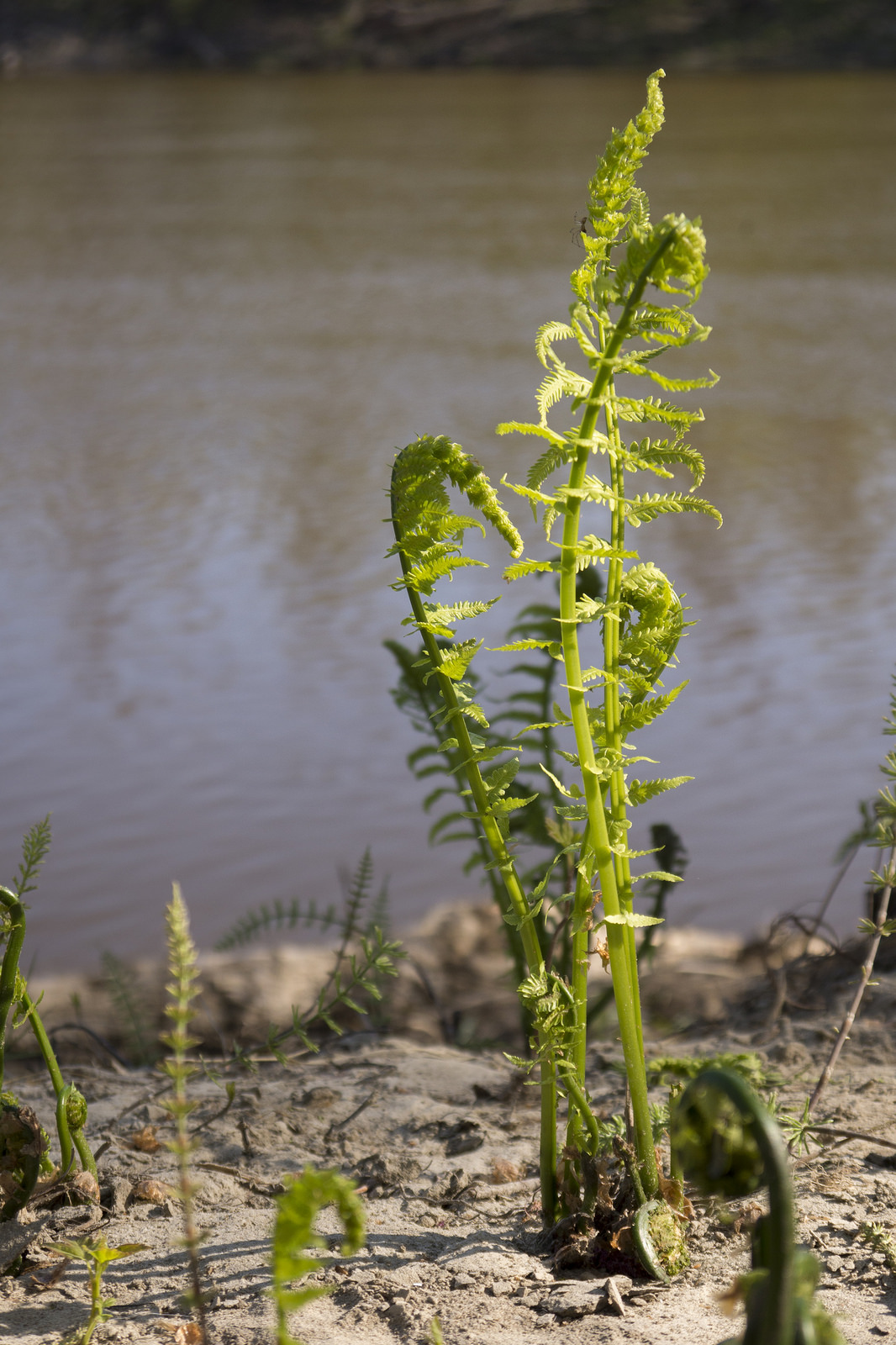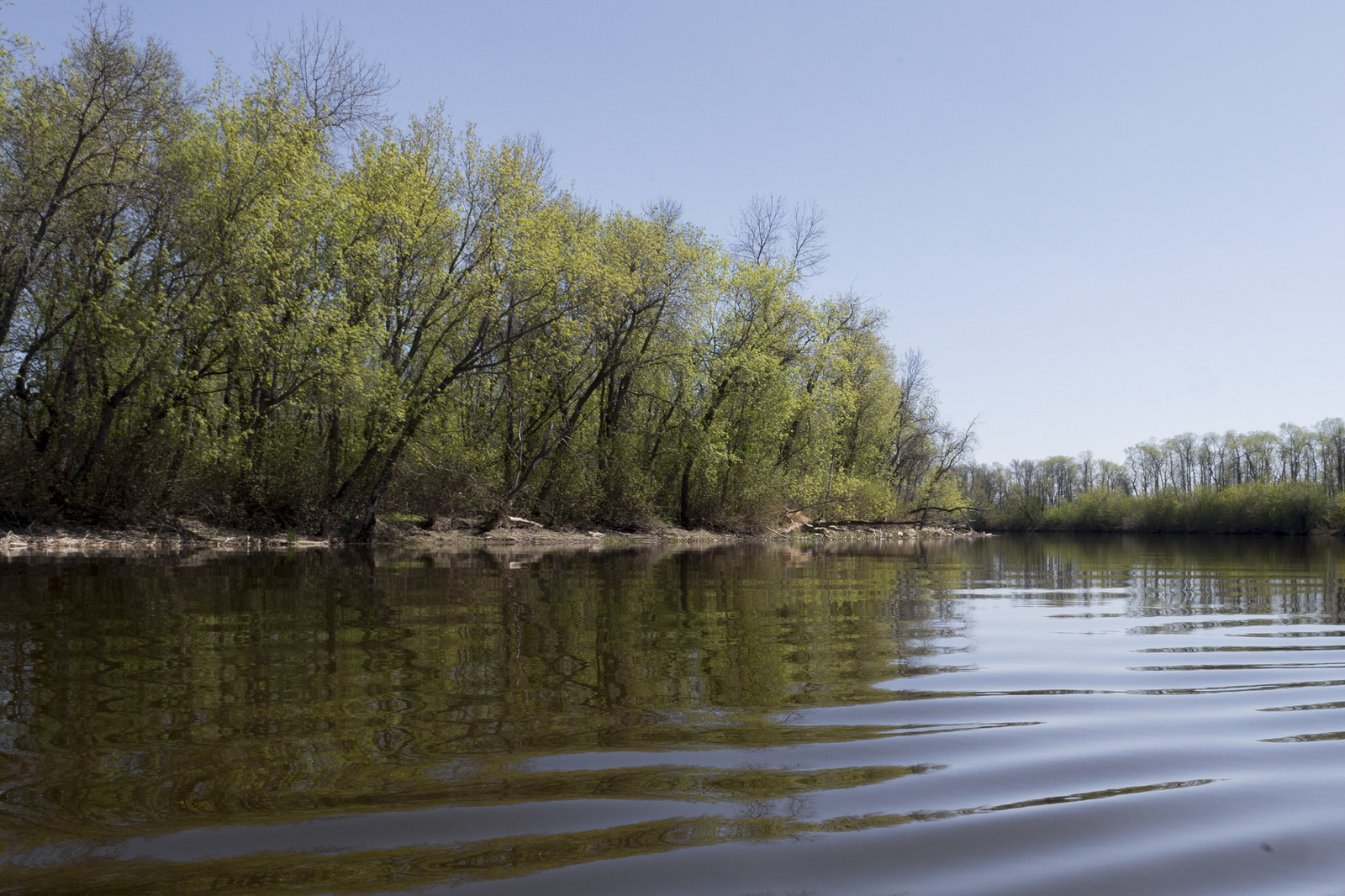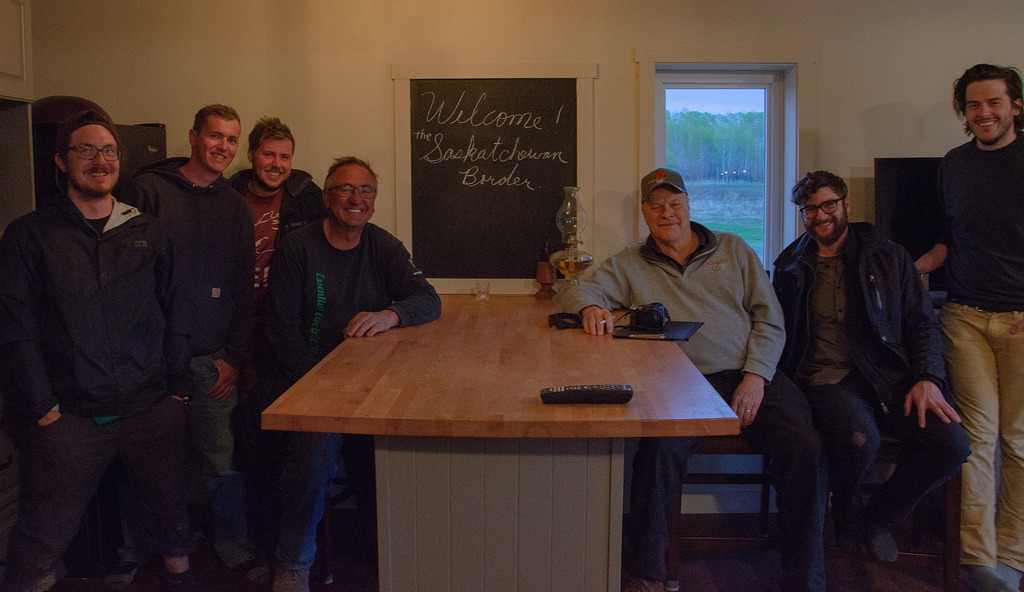Four days before our first canoe trip of the year, Sean and I stopped at Red Deer Lake to survey our exit point. Our plan was to canoe the Red Deer River (not to be confused with the river of the same name in southern Alberta) from the town of Hudson Bay in Saskatchewan across the border into Manitoba, roughly 120 kilometres in total.
The trip was to be a step up from our first river paddle, which was only 35 kilometres on the Assiniboine River after ending early due to rocks stripping some important bits of wood and fiberglass off my canoe. Still, I was determined to take the next challenge. That's why my guts twisted into knots as we rolled up to the shores of Red Deer Lake with wind blustering at 80 kilometres per hour:
The Red Deer River's exit channels are located 1.2 - 1.7km from the boat launch across open water.
We continued our pre-trip survey and visited the river entry point at Hudson Bay Regional Park and saw a long stretch of boiling rapids. They seethed, practically foaming at the mouth: "DIDN'T YOU LEARN YOUR LESSON THE FIRST TIME!? YOU DON'T KNOW CRAP ABOUT CANOEING RIVERS."
Sean and I were feeling discouraged. We talked to some locals and only got more conflicting information:
"A group just did the trip to Red Deer Lake a little over a week ago and made it in two days. The river was higher, though..."
"Skip the rapids and spend more time in the wild sections. The river flattens out near the lake; you'll be paddling hard."
"You're definitely going to want to start at Hudson Bay. That's the best rapids halfway to Erwood. You'll make good time."
After much deliberation, we figured we might as well dive in and do the whole river—rapids and all.
But I spent that night wide awake, thinking about flipping a canoe on a lake churning with oceanic waves (by prairie standards) and me and my bumbling crew, spinning down rapids in overloaded canoes. I read nearly every post on riskmanagementinscouting.com, scrounging last-minute bits of Internet wisdom and praying fervently for leadership from the almighty Boy Scouts of America. The red flags were piling up.
Our friends were relying on us for sound judgment. We rushed and underestimated our last river trip; we would not do it again.
Day One: Bill's Cabin
Thursday, May 17, 2018 — Our trip began at Erwood, Saskatchewan, ten minutes east of Hudson Bay. The light rain that accompanied us all morning was gone leaving the air cool and damp.
Sean, David and I had returned from dropping off the exit vehicle at Red Deer Lake and were anxious but eager to get on the water. It was already past 2 pm, true to our M.O., which was fine considering the logistics of organizing a canoe trip for seven people who live all over the province and refuse to respond to texts on time.
David and Andrew practice-punched eachother's life jackets while I looked for anyone willing to take my case of beer to lighten our jam-packed canoe. The three of us would be sardined in there for the next four-to-five days. The rest of the group, Mitch and Kendall, Nate and Gill, and Sean, were crowded around their canoes discussing the day's plan.
Taking our time to enjoy the river was our objective. But we still had a deadline to make, which was to get to Bill's cabin by 7 pm.
'We have twenty-seven kilometres to paddle today, so we should get going,' Sean said. 'The river current should help, but let's not keep Bill waiting.'
I had only met Bill Lozinski through email after he heard me on the radio talking about the Pasquia and Porcupine Hills a year ago. He was very knowledgeable about the area and its history, so he was the first person I went to when researching a trip on the Red Deer River. He was instantly prepared to give us the shirt off his back to make it happen, offering us the use of his cabin on the riverside for the night and sending us updates on water conditions leading up to the trip.
He also invited a local reporter to meet us at his cabin – the reason we didn't want to show up late looking like complete rookies.
'We are heavy,' Andrew said apprehensively as we pushed the canoe into the water. I stepped between the yoke and rear thwart and sat wobbly in a borrowed Helinox chair. David sat at the bow, Andrew at the stern. The canoe dipped deep into the river as the current took us ready or not.
We passed fluidly through the first set of rapids, boosting our confidence and untying stomach knots. Except for the semi-industrial agricultural landscape, the river was unlike the Assiniboine which had caused us grief a year ago.
The wind picked up and the river felt bleak and dreary. This, compounded with the bare flat-topped river ledges, made photos appear less than idyllic and more like paddling through oil spillage. It felt great to be back on the water and anticipation for what was to come was more than propellent.
'There's something about concrete, blue-trimmed bridges. It leaves a man inspired,' Andrew said pontificating about social cohesiveness and public works projects of the late 80s to early 90s.
I settled into the middle seat and had long given up pretending to help by throwing a limp paddle in the water now and then. So I proceeded to drink several beers. Call it confidence in the efficacy of friends.
The river carried us like a conveyor belt and we were making good time. There were several Class I-II rapids that were worth a cheap thrill and useful for learning how to paddle on moving water.
Forests gradually filled the shorelines the further we progressed. An enduring feature of the Red Deer River appeared to be the war of species among trees on either shore. One side would be composed almost entirely of aspen or birch stands, while the other was predominantly Manitoba maple with the odd elm and green ash.
Soon after the clouds cleared, the temperature chilled and we rounded the corner to Bill's cabin.
We boarded the shore half-cut and slightly windburned, where Bill and the reporter, Gene, were ready to greet us. After standing up I got a case of the "mal de debarquement" and took a moment to hold back the urge to puke before introductions.
Bill was visibly beaming.
'Wow, you guys look like a motley crew!'
Day Two: "There's No Rapids Past Erwood"
Friday, May 18, 2018 — The cabin was beautiful. Bill had already stopped by early in the morning to drop off a newspaper and an anthropology journal that detailed archaeological finds at the Red Deer River. With the coffee already brewing, I forgot we were still on a camping trip.
We cleaned the cabin and rehashed the previous night, wondering if we had offloaded enough "potent quotables" to make for a decent story in the local newspaper. But by the time we packed the canoes, our thoughts were on the trip again.
'I'm looking forward to getting into the backcountry mindset,' Sean said. There was a grumble of agreement. 'We've got twenty-five kilometres to do today and the rapids should be pretty much over. We can take a leisurely pace.'
I took my spot scrunched in the middle of the canoe and relaxed while Andrew and David pushed off from shore. The river was placid in the morning sun. I could feel the day's heat eagre to toast my skin, waiting for the ambient temperature to rise and make it happen.
'Would His Highness like a beer to start the morning?' Andrew asked. Yes, His would.
The river was still moving at conveyor belt-speed taking us past forests of increasing density. My assumption was that there would be a dramatic shift from maples to conifers, but I was wrong. A quote from the cartoon Bojack Horseman repeated in my head: "You know what they say about assuming – it makes an ass out of you and ming."
Before Sean and I had surveyed the river, we made guesses on behalf of our friends and the river itself. A part of me wanted to do the rapids from Hudson Bay forward to prove something: that we were bad ass risk taking sons-n'-daughters-of-bitches who always came out ahead. But it didn't sit well.
I learned that a group is only as strong as its weakest link. We have gear deficiencies. Experience deficiencies. Uncertainty. It takes surprisingly few missteps to be in trouble. Misjudge your distances or bank on perfect conditions and you could find yourself being pressured to make a potentially fatal crossing over a freezing-cold lake because so-and-so needs to get to work on time.
Having the space to relax on this trip left me with few regrets. That's why, when we turned a river corner and heard the low-level hiss of rumbling water, I felt excitement and not defecation.
Somewhere on the Red Deer, a switch had been flipped.
The riverbends became tighter. The modest banks with maples turned to eroded cliffsides topped with evergreens. Curious sights began to pop up, the first of which was a light-grey sandstone outcrop that appeared along the edges of the river like exposed bone.
I wondered if it was part of the silica sand deposits I had learned about. There was a remote extraction operation along the Red Deer River and underlying most of the plain is quartz-rich sand of a purity suitable for glass production. A few of us wanted to take samples of the grey sandstone but found it impractical to stop on the fast-running river.
I snapped as many photos as I could, but we were carried quickly and I struggled to stabilize.
Dozens of small birds flew in undecipherable circuits above. Sean pointed out that they seemed to be nesting in the sandstone cliffs where there were a number of holes burrowed. I wanted to stay longer but there was no pausing on this section of river.
Every time we dipped into a set of rapids, there was a cloud of flies to greet us. They would fuzz your vision like negative white noise, flying into every facial orifice, leaving you graciously with your daily intake of protein.
We had been travelling at a decent clip and the river showed no signs of slowing down. Whether for the sun or the exhaustion of being only fractionally in control at all times, we decided to keep a lookout for a suitable campsite.
Immediately, the holy grail presented itself: a long river flat, basking in sunlight, with a panoramic view of the highest cliffs we had seen on the river so far. The shores were a conglomerate of rock and grass that looked almost like old cobblestone.
Already sold, we beached our canoes and began community planning.
Stepping through the grass, I noticed the skeletal remains of a walleye. Then, what I believed to be sucker. Then, another sucker.
And another...
There were fish bones – some of which were remarkably intact – scattered all across the grass. It seemed like there were hundreds of spines, ribs, skulls, fins and scales, crossing the line from curiosity to questionable omen.
I passed Nate who was already walking back quickly toward the canoes. He said that Oaty had gone frolicking in the bush and came upon a black bear cub, which scurried up and down a tree, so camping there was out of the question as far as he was concerned.
I continued scouting not wanting to let go of such an idyllic, if somewhat ominous, camping spot.
At the end of the flat, I had just finished taking photos of the rapids when I saw the massive head of an adult black bear peeking above the shrubs. I made for the canoes walking hurriedly and trying to remain calm, which probably looked rigid and unconvincing for either species.
The group agreed to move on. From dry land the next rapids seemed fast, shallow and threatening so late in the day. But we were optimistic that we would find a safer, equally beautiful place to camp.
We departed soon after and found the rapids no worse than what we had done before. When canoeing on a river, you travel at the relative speed of the moving water, so what looked like trouble from shore felt more like being on a choppy lake.
But the ultimate campsite did not present itself. We paddled for another 45 minutes before getting anxious about the physical and mental state of the collective. The river had slowed and cliffs were sparse. We settled on a large sandy beach close to water access and a grove of gnarled maple trees which I felt were rather Halloween-ey. But it was nice.
Day Three: A Wilderness Product
Saturday, May 19, 2018 — Sniffling around the tent. Snapping branches in the woods. The pitter-patter of little mammalian feet. The dogs were up, so I went back to sleep.
I hadn't heard any human noises outside and did not want to be the first to make them. It was a cold night and I desperately wanted enough rest to enjoy the day fully. The tent was getting painfully bright but there was no giddy-up to be found.
By the time we finished breakfast and cleaned our site we might as well have had lunch. It would be a lazy day although we still had to complete a minimum of 25 kilometres if we were to reach the beginning of the river delta at a reasonable time on Sunday.
We only needed a few seconds of rapids-navigation to fully wake up. Andrew and David had become comfortable with their skills, so I felt no qualms about leaving my camera out of its dry case.
The previous day's scenery of rugged forest and crumbling sandstone had ended in favour of a more prim and proper exhibition of beaches, maples and aspen clones. Other features we had not yet become accustomed to were the presence of cabins on the edge of cliffs, which is apparently not at all precarious, and serious boulders hidden in shallow rapids.
David was now on high alert and communication with stern was crucial.
'We got a sleeper coming up on the left,' he said. Andrew was giggling loudly at something he said to Sean.
'ON THE LEFT.'
There was a thump and rattle that nearly upset the alignment of my chair and caused a missed sip of hard iced tea.
Andrew shouted an apology.
'Active paddles, everybody,' he said, grinning I assume. 'There appears to be a disturbulance in the matter stream ahead.'
A few thumps later, I got the sense the laissez-faire mood had passed and the boulders were becoming serious trouble. One in particular, narrowly missed, could have easily sent us flying into the river machine, upside-down, tangled in our own fishing line and ironic sleeveless shirts.
Nate and Gill seemed to effortlessly travel at a motorized clip and would routinely leave the group's line of sight. Meanwhile, Mitch and Kendall - whose first river canoe trip was this one - lagged behind, and Sean - paddling with the manpower of one - was taking on an excess of water.
I heard Sean far behind us, cursing a blue streak that sounded like Yosemite Sam over a background of birdsongs. He was frustrated with the group not staying together and had apparently reached his limit, which I had not considered and was a fair point.
We decided enough was enough and took a long break, hiding from the sun on a shaded beach.
Some of the group had been collecting fiddleheads all trip and we had found another motherlode. Figuring it would make a good lunch and possibly imbue us with forest powers, we washed them in the stream and fried them over a gas stove. They tasted like asparagus, with a slight zap of bitterness I'd compare to licking a used nine-volt battery (in a good way.)
We beached for a long time. A trapper's cabin was across the stream but we did not see any point in investigating it as cabins appeared to be a semi-common thing on the Red Deer River. I was getting used to watching scenery pass by the side of a canoe and started to miss the primeval draw of hiking into the woods with only a shallow stream for a trail.
Back on the water, we found ourselves needing to paddle to maintain a decent speed. We were getting to be within a few kilometres of Red Deer Lake and the likelihood of any more rapids was gone. But we gained a new experience: the birds. Songs came from all places at once. We watched slack-jawed as a bird of prey, clutching a writhing, gold-bellied fish, flew from its perch high in the aspen trees and through the river's aisle.
We once again forfeited the ultimate camping spot at a horseshoe bend in the river for the sake of moving forward. By the time we had gone too far to backtrack we realized the gems were far and few between and we would have to settle, again.
Shorelines were waterlogged silt, sand and clay. Even several paces into the forest the ground was soft and wet. This was not something likely to change downstream so we backtracked until we found a suitable beach that led up to a dry plateau. Docking was a challenge on the steep banks and there was no way to debark without stepping knee-deep into mud.
The higher ground was dry as we hoped and the forest was unlike any we had camped in before. Maples made a lush canopy over the sandy floor which appeared to be bursting with young ostrich ferns as far as the eye could see. I would normally feel strongly against camping in ferns to preserve their niceness, but we were clearly outnumbered.
We set up our tents and gathered around our communal centre for dinner in the dark.
Sean was on his last round of bush pies, which up until now had included some winners (Spam n' Cheese) and some losers (Vienna Sausage Surprise). Mitch and Kendall had some healthy-looking, probably rice-based thing going on, while Andrew synthesized a spaghetti sauce, only to have it ruined by a chemical mishap that somehow left the noodles both undercooked and overcooked. I had creamy parmesan Sidekicks with a can of flaked white tuna for some oomf. Nate and Gill prepared a melange of KD, beef jerky and dried vegetables, while David ate quiet spoonfuls of a highly suspect backpacker's meal labeled "Macaroni and Cheese Product."
The final night is always a haze.
Day Four: The Delta Blues
Sunday, May 20, 2018 — With less than 20 kilometres to go before reaching the finish line, there was no rush to pack. The early morning sky was electric blue, the weather forecast was in our favour and wind gusts were expected to be around 16 kilometres per hour, which seemed about as good as anyone could ask for.
The ferns were stretching in the sun as we packed and left the campsite. But the dominant presence was once again the birds which sang a concerto over wind brushing the forest canopy.
It was immediately apparent there would be no more river current to push us forward. The remainder of the trip would be self-propelled only.
When planning the trip, the Red Deer River Delta was the most troublesome unknown. Sean and I had no idea what it would look like, what trees lived there or if there would be shelter for inclement weather. We only knew what it looked like from satellite imagery, which was like a racetrack with only thin, brambly levees separating the river from open water on Red Deer Lake.
One of the locals we had talked to recalled doing the trek from Hudson Bay to Red Deer Lake, but they were not so lucky with the weather. The conditions on Red Deer Lake were too windy to cross, so they were forced to stay an extra two days and had to backtrack several kilometres just to find suitable land for shelter.
We opted to use our extra time as a buffer if the weather should keep us hostage. But we were lucky on all accounts and had used our extra time for rest, relaxation and general laziness. Sean, however, remained apprehensive about the conditions until the bitter end.
About halfway through the delta, Sean suggested we stop.
'The lake should only be about a hundred metres through the bush,' he said. 'We should check it out.'
There was little uptake from the group, including myself—a hard "meh."
Sean was getting irked. He continued: 'Why wouldn't you want to at least see if there's whitecaps? If the wind's coming through the river channel it could be worse on the lake.'
Most of the group either couldn't hear him or chose to ignore him. I felt like it might be worth stopping if seeing the lake would quell anxiety, but there were only two possible scenarios: the lake is choppy, in which case we paddle the rest of the channel with looming dread, or the lake is calm and we paddle the rest of the channel praying to the Boy Scouts of America that the conditions haven't changed. There was still up to two hours of distance to cover, which left few reasons to stay—in my opinion at least.
We floated past the opportunity.
'I swear to God, if the lake just sucks and someone starts pushing to cross I'm going to throw punches,' Sean said.
The delta channel remained relatively placid and the sky was showing no signs of impending doom. There were only occasional wind gusts which made Sean's expression contort into something Rex Murphy-esque. But if our campsite follies taught me anything it was to never spit a blessing in the face, make hay while the sun shines, live each day, and other slogans.
Paddling the delta took more effort than any of the river upstream. It seemed to go on and on with few if any changes in scenery until we reached the fork where we could see the end of the river.
The trees thinned and gave way to long grass, which made the finishing line auspiciously bright as we approached the lake. It looked perfect reflecting the sky's brilliant azure.
We took a short break to regroup before making the cross. We would take a slightly longer route so that the wind might push us in the direction of the boat launch, but we needed to cross as quick as possible. This would require all hands on deck.
'Andy, you've paddled maybe a total of five minutes this trip,' Andrew said, which was absurd. 'And we already stopped six times for ennui so don't even bring it up.'
Halfway across the lake, things appeared to be going well so I welched on my paddling duties one last time.
We could see the edge of the Porcupine Hills on the southeastern horizon. From so far away the hills seemed small and simple, which only made my memories of hiking Steeprock River and Armit River, absorbed in the micro-level detail of lush boreal jungle, a welcoming thought.
It took roughly 10 minutes to cross the lake and there was a short bout of wind gusts, but we made it to shore without a panic attack.
As a landlubber, the Red Deer River trip's lazy pace was a welcome change compared to some of the more challenging trips we've been on. It was the perfect river for a group of beginners, and although I can't take credit for paddling, I learned a few things about assumptions, perceived risk and social cohesiveness.
My advice: if you're new to backcountry canoeing and want to enjoy yourself, talk to the locals, learn as much as possible about the river, and know your skill/experience-level. But the map is not the territory and there will always be risk and uncertainty. Always bring friends who are patient, capable, and trustworthy — then take the middle seat and let them do all the work.
A special thanks to Bill and Marion Lozinski for helping make this trip possible,
and for trusting a strange group of millenials with their cabin.







